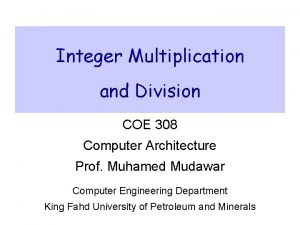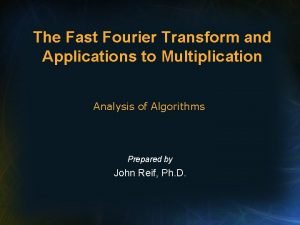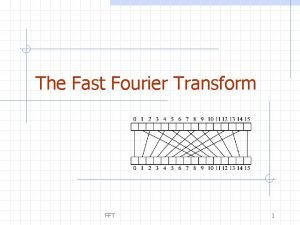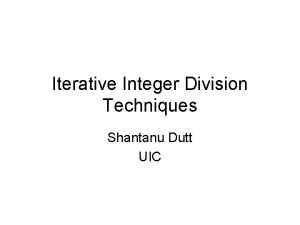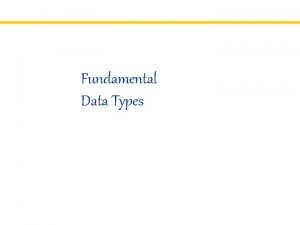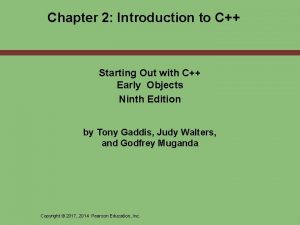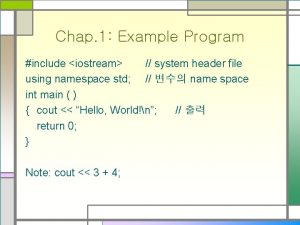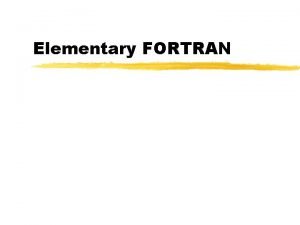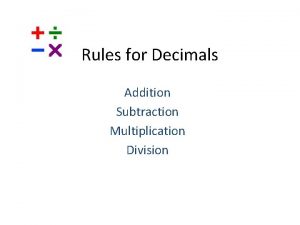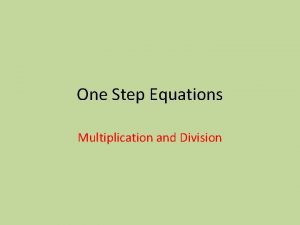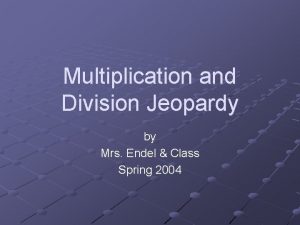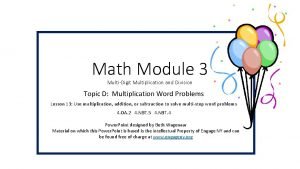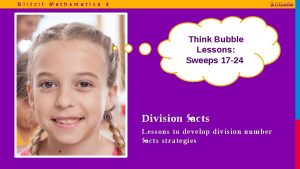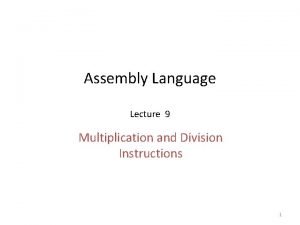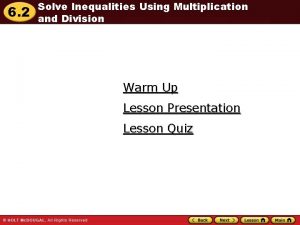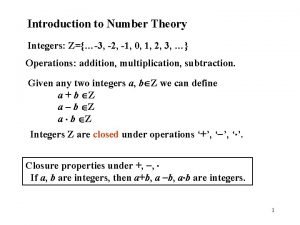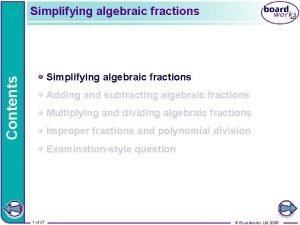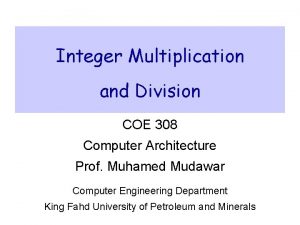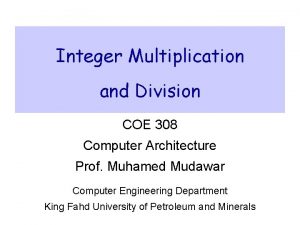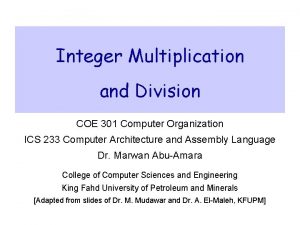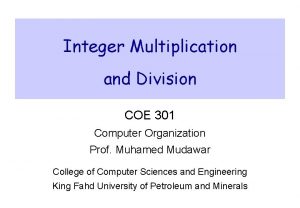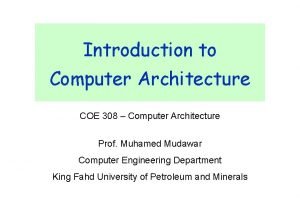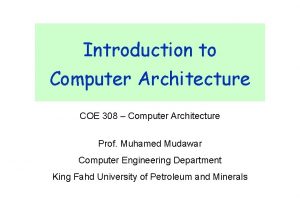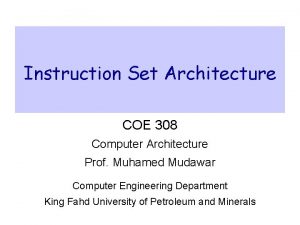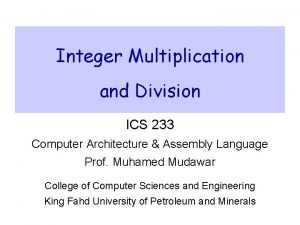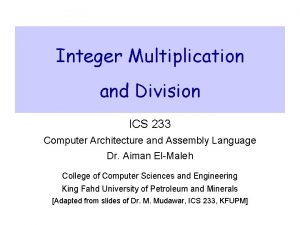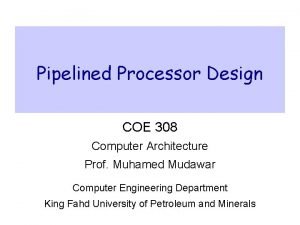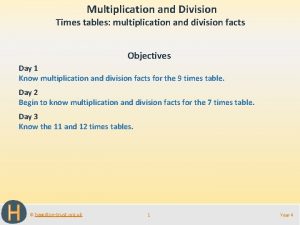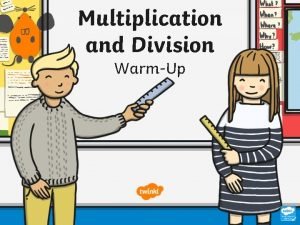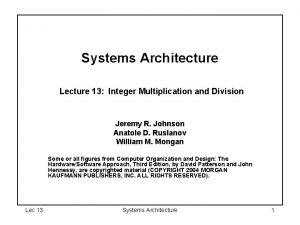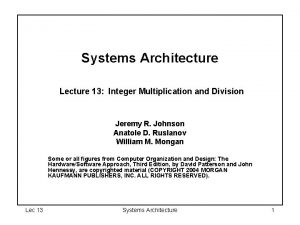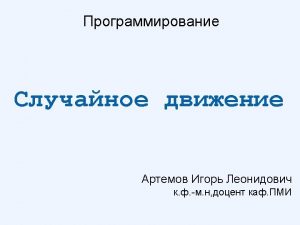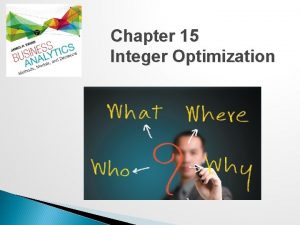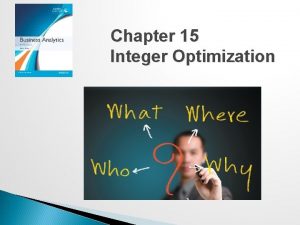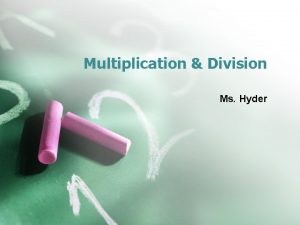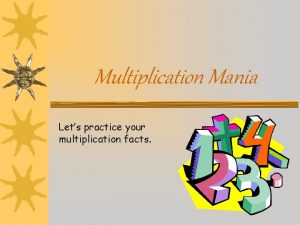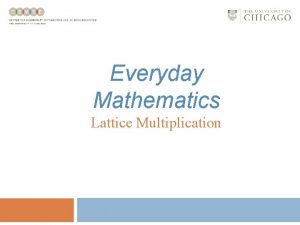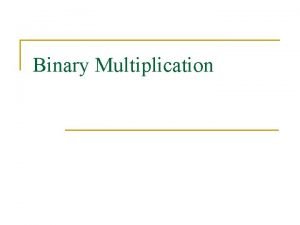Integer Multiplication and Division COE 308 Computer Architecture
























- Slides: 24

Integer Multiplication and Division COE 308 Computer Architecture Prof. Muhamed Mudawar Computer Engineering Department King Fahd University of Petroleum and Minerals

Presentation Outline v Unsigned Multiplication v Signed Multiplication v Faster Multiplication v Unsigned Division v Signed Division Integer Multiplication and Division COE 308 – Computer Architecture © Muhamed Mudawar – slide 2

Unsigned Multiplication v Paper and Pencil Example: Multiplicand Multiplier × 11002 = 12 11012 = 13 1100 0000 1100 Product Binary multiplication is easy 0 × multiplicand = 0 1 × multiplicand = multiplicand 100111002 = 156 v m-bit multiplicand × n-bit multiplier = (m+n)-bit product v Accomplished via shifting and addition v Consumes more time and more chip area than addition Integer Multiplication and Division COE 308 – Computer Architecture © Muhamed Mudawar – slide 3

Sequential Unsigned Multiplication v Initialize Product = 0 v Check each bit of the Multiplier v If Multiplier bit = 1 then Product = Product + Multiplicand v Rather than shifting the multiplicand to the left Instead, Shift the Product to the Right Has the same net effect and produces the same result Minimizes the hardware resources v One cycle per iteration (for each bit of the Multiplier) ² Addition and shifting can be done simultaneously Integer Multiplication and Division COE 308 – Computer Architecture © Muhamed Mudawar – slide 4

Sequential Multiplication Hardware v Initialize HI = 0 Start v Initialize LO = Multiplier HI = 0, LO=Multiplier v Final Product = HI and LO registers v Repeat for each bit of Multiplier =1 =0 LO[0]? Multiplicand 32 bits 32 -bit ALU carry HI = HI + Multiplicand 32 bits add Shift (Carry, HI, LO) Right 1 bit 32 bits shift right HI LO 64 bits 32 nd Repetition? Control write No Yes Done LO[0] Integer Multiplication and Division COE 308 – Computer Architecture © Muhamed Mudawar – slide 5

Sequential Multiplier Example v Consider: 11002 × 11012 , Product = 100111002 v 4 -bit multiplicand multiplier are used in this example v 4 -bit adder produces a 5 -bit sum (with carry) Iteration 0 1 2 3 4 Multiplicand Initialize (HI = 0, LO = Multiplier) Product = HI, LO 0000 1101 1100 + LO[0] = 1 => ADD Shift Right (Carry, HI, LO) by 1 bit Carry 0 1101 1100 0110 1100 0011 LO[0] = 0 => Do Nothing Shift Right (Carry, HI, LO) by 1 bit LO[0] = 1 => ADD + Shift Right (Carry, HI, LO) by 1 bit + Integer Multiplication and Division 1100 COE 308 – Computer Architecture 1111 0011 0111 1001 1100 LO[0] = 1 => ADD Shift Right (Carry, HI, LO) by 1 bit 0 1 0011 1001 1100 © Muhamed Mudawar – slide 6

Next. . . v Unsigned Multiplication v Signed Multiplication v Faster Multiplication v Unsigned Division v Signed Division Integer Multiplication and Division COE 308 – Computer Architecture © Muhamed Mudawar – slide 7

Signed Multiplication v So far, we have dealt with unsigned integer multiplication v First Attempt: ² Convert multiplier and multiplicand into positive numbers § If negative then obtain the 2's complement and remember the sign ² Perform unsigned multiplication ² Compute the sign of the product ² If product sign < 0 then obtain the 2's complement of the product v Better Version: ² Use the unsigned multiplication hardware ² When shifting right, extend the sign of the product ² If multiplier is negative, the last step should be a subtract Integer Multiplication and Division COE 308 – Computer Architecture © Muhamed Mudawar – slide 8

Signed Multiplication (Pencil & Paper) v Case 1: Positive Multiplier Multiplicand Multiplier × 11002 = -4 01012 = +5 Sign-extension 11111100 Product 111011002 = -20 v Case 2: Negative Multiplier Multiplicand Multiplier Sign-extension Product Integer Multiplication and Division × 11002 = -4 11012 = -3 11111100 00100 (2's complement of 1100) 000011002 = +12 COE 308 – Computer Architecture © Muhamed Mudawar – slide 9

Sequential Signed Multiplier v ALU produces 32 -bit result + Sign bit v Check for overflow Start HI = 0, LO = Multiplier ² No overflow Extend sign-bit of result ² Overflow Invert extended sign bit Multiplicand 32 bits =0 LO[0]? First 31 iterations: HI = HI + Multiplicand Last iteration: HI = HI – Multiplicand 32 bits 32 -bit ALU =1 add, sub Shift Right (Sign, HI, LO) 1 bit sign 32 bits shift right HI LO 64 bits 32 nd Repetition? Control write No Yes Done LO[0] Integer Multiplication and Division COE 308 – Computer Architecture © Muhamed Mudawar – slide 10

Signed Multiplication Example v Consider: 11002 (-4) × 11012 (-3), Product = 000011002 v Check for overflow: No overflow Extend sign bit v Last iteration: add 2's complement of Multiplicand Iteration 0 1 2 3 4 Multiplicand Initialize (HI = 0, LO = Multiplier) Product = HI, LO 0000 1101 1100 + LO[0] = 1 => ADD Shift (Sign, HI, LO) right 1 bit Sign 1 1100 1101 1100 1110 0110 1100 1111 0011 LO[0] = 0 => Do Nothing Shift (Sign, HI, LO) right 1 bit LO[0] = 1 => ADD + Shift (Sign, HI, LO) right 1 bit 1100 LO[0] = 1 => SUB (ADD 2's compl) 0100 + Shift (Sign, HI, LO) right 1 bit Integer Multiplication and Division COE 308 – Computer Architecture 1 1011 0011 1101 1001 0 0001 1001 0000 1100 © Muhamed Mudawar – slide 11

Next. . . v Unsigned Multiplication v Signed Multiplication v Faster Multiplication v Unsigned Division v Signed Division Integer Multiplication and Division COE 308 – Computer Architecture © Muhamed Mudawar – slide 12

Using Multiple Adders v 32 -bit adder for each bit of the multiplier 33 bits 32 bits 1 32 -bit A B 3 1 32 -bit 32 bits ² Product = accumulated shifted sum 33 bits 32 bits ² Most significant bit is a carry bit 1 32 -bit B 31 ² Upper 32 bits go to next adder v Array multiplier can be optimized ² Carry save adders reduce delays Integer Multiplication and Division A B 2 ² AND multiplicand with each bit of multiplier ² Least significant bit is a product bit B 0 32 bits ² 31 adders are needed for a 32 -bit multiplier v Each adder produces a 33 -bit output A A B 1 COE 308 – Computer Architecture 33 bits A . . . 32 bits 1 32 bits 32 -bit 33 bits 32 bits P 63. . 32 1 bit P 31. . P 3 P 2 P 1 P 0 © Muhamed Mudawar – slide 13

Carry Save Adders v Used when adding multiple numbers (as in multipliers) v All the bits of a carry-save adder work in parallel ² The carry does not propagate as in a carry-propagate adder ² This is why a carry-save is faster than a carry-propagate adder v A carry-save adder has 3 inputs and produces two outputs ² It adds 3 numbers and produces partial sum and carry bits a 31 b 31 cout + . . . s 31 a 1 b 1 a 0 b 0 + + s 1 s 0 a 31 b 31 c 31 + cin c'31 s'31 Carry-Propagate Adder Integer Multiplication and Division COE 308 – Computer Architecture a 1 b 1 c 1 a 0 b 0 c 0 . . . + + c'1 s'1 c'0 s'0 Carry-Save Adder © Muhamed Mudawar – slide 14

Wallace Tree Multiplier - 1 of 2 v Suppose we want to multiply two numbers A and B ² Example on 4 -bit numbers: A = a 3 a 2 a 1 a 0 and B = b 3 b 2 b 1 b 0 v Step 1: AND (multiply) each bit of A with each bit of B ² Requires n 2 AND gates and produces n 2 product bits ² Position of aibj = (i+j). For example, Position of a 2 b 3 = 2+3 = 5 a 3 b 0 a 2 b 0 a 1 b 0 a 3 b 1 a 2 b 1 a 1 b 1 a 0 b 1 a 3 b 2 a 2 b 2 a 1 b 2 a 0 b 2 a 2 b 3 a 1 b 3 a 0 b 3 A×B a 3 b 3 Integer Multiplication and Division COE 308 – Computer Architecture a 0 b 0 © Muhamed Mudawar – slide 15

Wallace Tree Multiplier – 2 of 2 Step 2: Use carry save adders to add the partial products ² Reduce the partial products to just two numbers Step 3: Add last two numbers using a carry-propagate adder a 3 b 1 a 2 b 2 a 3 b 0 a 2 b 1 a 2 b 0 a 1 b 1 a 1 b 2 + + a 1 b 0 a 0 b 1 a 0 b 0 a 0 b 2 + + a 3 b 2 a 2 b 3 a 1 b 3 a 0 b 3 + + + + P 6 P 5 P 4 P 3 + Carry Save Adder a 3 b 3 P 7 Integer Multiplication and Division COE 308 – Computer Architecture Carry Propagate Adder P 2 P 1 P 0 © Muhamed Mudawar – slide 16

Next. . . v Unsigned Multiplication v Signed Multiplication v Faster Multiplication v Unsigned Division v Signed Division Integer Multiplication and Division COE 308 – Computer Architecture © Muhamed Mudawar – slide 17

Unsigned Division (Paper & Pencil) 100112 = 19 Divisor 10112 Dividend = Quotient × Divisor + Remainder 217 = 19 × 11 + 8 110110012 = 217 -1011 10 10100 -1011 10011 -1011 10002 = 8 Integer Multiplication and Division COE 308 – Computer Architecture Quotient Dividend Try to see how big a number can be subtracted, creating a digit of the quotient on each attempt Binary division is accomplished via shifting and subtraction Remainder © Muhamed Mudawar – slide 18

Sequential Division v Uses two registers: HI and LO v Initialize: HI = Remainder = 0 and LO = Dividend v Shift (HI, LO) LEFT by 1 bit (also Shift Quotient LEFT) ² Shift the remainder and dividend registers together LEFT ² Has the same net effect of shifting the divisor RIGHT v Compute: Difference = Remainder – Divisor v If (Difference ≥ 0) then ² Remainder = Difference ² Set Least significant Bit of Quotient v Observation to Reduce Hardware: ² LO register can be also used to store the computed Quotient Integer Multiplication and Division COE 308 – Computer Architecture © Muhamed Mudawar – slide 19

Sequential Division Hardware v Initialize: Start ² HI = 0, LO = Dividend v Results: 1. Shift (HI, LO) Left Difference = HI – Divisor ² HI = Remainder ² LO = Quotient ≥ 0 Divisor sub 32 -bit ALU sign Difference 32 nd Repetition? write 32 bits <0 2. HI = Remainder = Difference Set least significant bit of LO 32 bits HI Difference? LO 32 bits Control shift left No Yes Done set lsb Integer Multiplication and Division COE 308 – Computer Architecture © Muhamed Mudawar – slide 20

Division Example v Example: 11102 / 00112 (4 -bit dividend & divisor) v Result Quotient = 01002 and Remainder = 00102 v 4 -bit registers for Remainder and Divisor (4 -bit ALU) Iteration 0 1 2 3 4 HI LO Divisor Difference Initialize 0000 1110 0011 1: Shift Left, Diff = HI - Divisor 0001 1100 0011 1110 1: Shift Left, Diff = HI - Divisor 0011 1000 0011 0000 2: Rem = Diff, set lsb of LO 1: Shift Left, Diff = HI - Divisor 0000 0001 1001 0010 0011 1110 0010 0100 0011 1111 2: Diff < 0 => Do Nothing 1: Shift Left, Diff = HI - Divisor 2: Diff < 0 => Do Nothing Integer Multiplication and Division COE 308 – Computer Architecture © Muhamed Mudawar – slide 21

Next. . . v Unsigned Multiplication v Signed Multiplication v Faster Multiplication v Unsigned Division v Signed Division Integer Multiplication and Division COE 308 – Computer Architecture © Muhamed Mudawar – slide 22

Signed Division v Simplest way is to remember the signs v Convert the dividend and divisor to positive ² Obtain the 2's complement if they are negative v Do the unsigned division v Compute the signs of the quotient and remainder ² Quotient sign = Dividend sign XOR Divisor sign ² Remainder sign = Dividend sign v Negate the quotient and remainder if their sign is negative ² Obtain the 2's complement to convert them to negative Integer Multiplication and Division COE 308 – Computer Architecture © Muhamed Mudawar – slide 23

Signed Division Examples 1. Positive Dividend and Positive Divisor ² Example: +17 / +3 Quotient = +5 Remainder = +2 2. Positive Dividend and Negative Divisor ² Example: +17 / – 3 Quotient = – 5 Remainder = +2 3. Negative Dividend and Positive Divisor ² Example: – 17 / +3 Quotient = – 5 Remainder = – 2 4. Negative Dividend and Negative Divisor ² Example: – 17 / – 3 Quotient = +5 Remainder = – 2 The following equation must always hold: Dividend = Quotient × Divisor + Remainder Integer Multiplication and Division COE 308 – Computer Architecture © Muhamed Mudawar – slide 24
 Integer operations
Integer operations What is multiplicand and multiplier example
What is multiplicand and multiplier example Negative wrapped convolution
Negative wrapped convolution Java fft
Java fft Floating point division algorithm in computer architecture
Floating point division algorithm in computer architecture R integer division
R integer division Integer division c++
Integer division c++ This operator performs integer division.
This operator performs integer division. Integer division c++
Integer division c++ The identifier 1stnum is a valid identifier.
The identifier 1stnum is a valid identifier. Multiplication division rules
Multiplication division rules One step equation multiplication
One step equation multiplication Multiplication and division properties
Multiplication and division properties Multiplication and division jeopardy
Multiplication and division jeopardy 13773x
13773x Parts of a multiplication equation
Parts of a multiplication equation Year 4 multiplication and division
Year 4 multiplication and division Multiplying and dividing uncertainties
Multiplying and dividing uncertainties Multiplying numbers in scientific notation worksheet
Multiplying numbers in scientific notation worksheet Multiplication facts and division facts
Multiplication facts and division facts Assembly language division
Assembly language division How to solve inequalities using multiplication and division
How to solve inequalities using multiplication and division Multiplying integers worksheets
Multiplying integers worksheets Algebraic fractions multiplying and dividing
Algebraic fractions multiplying and dividing Order of operations jeopardy
Order of operations jeopardy

